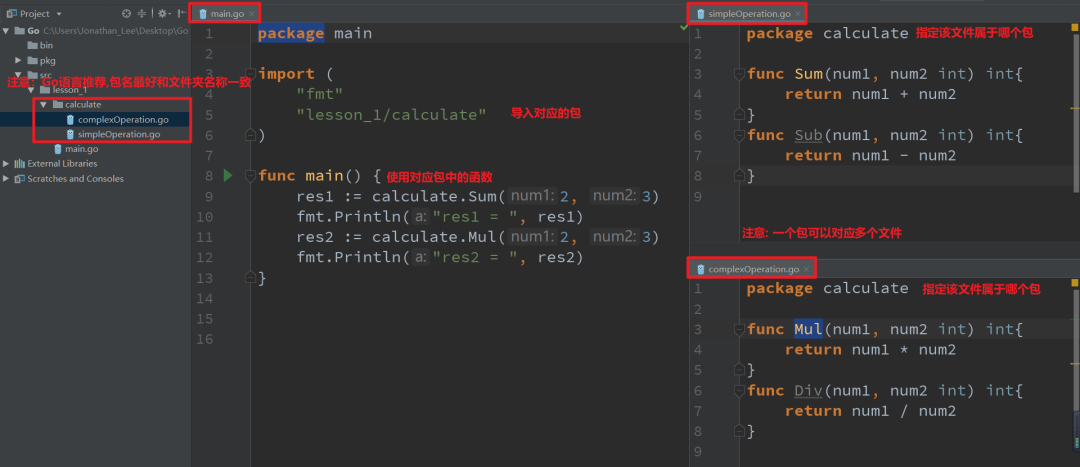Go language introduction detailed knowledge, mainly to share with you go language composition, go language function format, C language to go language comparison.
Go language program composition
-
Like C language program, Go language program is also composed of many functions
-
Like C language programs, the system * automatically calls a function called main when the program runs
-
Like C language programs, if a program does not have a main function, the program does not have the ability to run
-
Like C language programs, a Go language program has and can only have one main function
Go language program main function definition format
-
C language main function format
int main(int argc, const char * argv[]) {
return 0;
}
-
Go language main function format
-
func tells the system that this is a function
-
Main main function fixed name
-
The left parenthesis of a function must be on the same line as the function name
-
The main function must be in the main package
-
//Tell the system which package the currently written code belongs to
package main
//Defines a function called main
func main() {
}
Go language HelloWorld
package main //Tell the system that the current code belongs to the main package
import "fmt" //Import fmt package corresponding to print function
func main() {
//By package name Function name, using the print function in fmt package to output statements
fmt.Println("Hello World!!!")
}
Similarities and differences between Go language HelloWorld and C language HelloWorld
-
1. Different file types
-
c language code is saved in c is the suffix of the file
-
The go language code is saved in In files with go suffix
-
-
2. Different code management methods
-
We will put different types of code into different go file, and then assign a package name to the file through package
-
If necessary, you can directly import the corresponding package name through import

-
c language will put different types of code into different c file, and then write the corresponding h file
-
If necessary, import the corresponding files directly through #include h file is enough

-
C language programs manage code in the form of files
-
Go language program manages code in the form of package
-
-
3. The main function writing file is different
-
The main function in C language can be written in any file, as long as a program has only one main function
-
In Go language, the main function can only be written in the folder named main in the package. Similarly, a program needs to be saved, and there is only one main function
-
4. Functions are written in different formats
-
Note: the left bracket of C language function can be on the same line as the function name or not
-
The format of function in C language is
-
return type Function name(parameter list ) {
Function body related statements;
return Return value;
}
-
-
Note: the left bracket of Go language function must be on the same line as the function name, otherwise an error will be reported
-
Go language function definition format
-
func Function name(parameter list )(Return value list) {
Function body related statements;
return Return value;
}
-
5. The format of function call is different
-
C language is imported through #include h file, call the function directly through the function name
-
After the Go language imports the corresponding package through import, it needs to pass the package name Called by function name
-
#include <stdio.h>
#include "calculate.h"
int main()
{
int res = sum(2, 3); //Call the function directly with the function name
printf("res = %d!\n", res);
return 0;
}
package main
import (
"fmt"
"lesson_1/calculate"
)
func main() {
res := calculate.Sum(2, 3) //Use package name Function name calling function
fmt.Println("res1 = ", res)
}
-
6. The statement ends differently
-
Every statement in C language must end with a semicolon
-
There is no need to add a semicolon after each statement in Go language (the compiler will add it automatically)
-
#include <stdio.h>
#include "calculate.h"
int main()
{
int res = sum(2, 3); //If you don't write a semicolon, you will report an error
printf("res = %d!\n", res); //If you don't write a semicolon, you will report an error
return 0; //If you don't write a semicolon, you will report an error
}
package main
import (
"fmt"
"lesson_1/calculate"
)
func main() {
res := calculate.Sum(2, 3) //Don't write semicolons
fmt.Println("res1 = ", res) //Don't write semicolons
}
Go language notes
-
Like C language, Go language also supports single line comments and multi line comments, and the characteristics of all comments are the same as C language
-
Single line comment / / annotated content
-
Multiline comment / * annotated content*/
-
-
In the Go language, the official recommends using single line comments rather than multi line comments (for details, you can directly view the official Go source code)